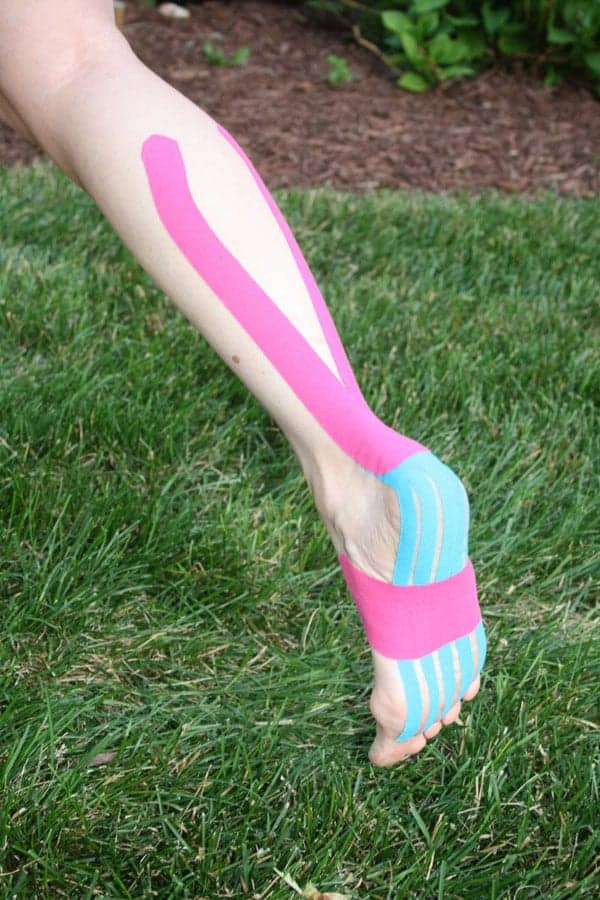An overview of different taping types and their application in sports medicine.
Brian J. Adams, PT, DPT, OCS, CSCS

Recently, however, there have been published studies that illustrate some positive findings in regard to the benefits of therapeutic taping practices. These studies will help pave the way for the growing trend of taping practitioners…and colorful athletes.
For the purpose of this article, discussion will address two types of tape that are widely accepted in sports medicine practices: 1) elastic therapeutic tape or stretch taping, used in kinesiology taping techniques, and 2) strapping or supportive taping, commonly used in McConnell taping techniques. (The use of white athletic tape is generally reserved for mechanical support of an unstable joint, and will not be addressed in this article.) This will be followed up with some current research that will help illustrate the use of these taping methods.
KINESIOLOGY TAPING: A DYNAMIC TREATMENT
Through research, development, and marketing, there is now a vast array of “flexible tape” products available, each said to have its own unique qualities and attributes. For the simplicity of this article, we will refer to these flexible tape products and methods as kinesiology taping (KT). These products are offered in a variety of colors, lengths, and precuts, and continuing education is made available to help clinicians better understand the taping techniques. Some companies offer certification programs to become a credentialed clinician.
The tape is typically latex free and hypoallergenic, and can be applied and left in place for several days. This holds true even during rigorous exercise, swimming, and showering. The ability of the tape to move and stretch has made it popular with many athletes, as it does not limit normal physiological motion. Most of the tape is readily available to clinicians and patients, and a brief tutorial by a clinician can be a great starting point for patients to improve their own health through self-care, application, and compliance.
In the world of taping techniques, there are different “corrections” that can be made with the appropriate KT application. These corrections include: mechanical, fascial, space, ligament/tendon, functional, and circulatory/lymphatic. Depending on the number of tape strips, as well as the type of strip used, the amount of tension, and the direction of the application, an experienced practitioner can address each of these corrections. Utilization of specific KT techniques in the clinic can afford the clinician an extra “tool in the toolbox” when battling some common diagnoses.
Although KT has become widely used and is seemingly effective, the actual mechanism of how it works is not always clear. The tape holds no specific medicinal ingredients, and each manufacturer touts a rationale for success. A majority of feedback from clinicians is based on functional test/retest of patients using KT, and is heavily weighted on patient reports of pain and symptom reduction. As we will discuss later, the research often supports the premise that pain is a large player in the successful outcomes of KT applications.
STRAPPING TAPE: A RIGID SOLUTION
Developed years ago by Jenny McConnell, PT, the McConnell taping methods have been utilized by clinicians and supported by literature when dealing with many common knee and shoulder diagnoses. Base tape and strapping tape, with varying directions and tension, are used together to help correct poor joint mechanics, support surrounding tissues, or stimulate the neuromuscular system in an attempt to facilitate normal function. It, too, can be used in the clinic, and taught to patients so that home compliance is improved. Typically, the rigid strapping tape can be left on for approximately 18 hours, depending on patient tolerance. As with KT, the use of home education and self-application of strapping tape can prove beneficial.
There are a variety of sources of the tape used in McConnell taping techniques. For the knee, these tapes are commonly used to correct for malalignment of the patella in relation to the femur. The application consists of applying base tape to protect the skin, and utilizing the strapping tape to produce the force/counterforce desired. This same concept is applied to the shoulder, AC joint, and postural diagnoses.
Ongoing research supports the use of McConnell taping methods in specific applications. Given the nature of adhesives and the potential for skin irritation, the strapping tape can have limited applications in patient populations that cannot tolerate the treatment.
BRACING: WHEN TAPING IS NOT ENOUGH
When considering endurance athletics, many sports demand a high volume of load through the joints over the course of training and competition. Some of the more vulnerable joints are the knee (in running and cycling), the shoulder (in swimming), and the elbow (in golf and tennis). For the knee, complaints of anterior knee pain can stem from the patellar tendon and patella-femoral joints. Any malalignment or tracking issue within the knee can quickly become a problem, while repetitive tensile loading of the patellar tendon can stop runners or cyclists in their tracks. For these diagnoses, there may be indication for the use of a counterforce brace, lateral buttress braces, and straps designed to dynamically affect knee joint kinematics and reduce patella-femoral pain.
In sports such as tennis and golf, the development of lateral epicondylitis can hinder even the seasoned professional. The overuse and irritation of the lateral extensor group of the wrist/elbow develops, akin to patellar tendinitis. With the use of a counterforce strap around the elbow, tensile forces on the tendon can be reduced, allowing improved function with less irritation of the tissues.
As with most bracing applications, these solutions are meant for short-term use to aid in the recovery and rehabilitation of soft tissues, while a long-term solution is sought in regard to mechanics, arthrokinematics, and sport-specific form.
EVIDENCE: WHAT THE CURRENT RESEARCH SUPPORTS
Conducting a PubMed search for kinesiology taping over the past 5 years resulted in 42 studies, while a search for McConnell taping resulted in 11 studies. A brief summary of these findings appears below. (This is not meant to be an exhaustive list, but an overview of current concepts.)
• In July 2008, Thelen et al published a research report in the Journal of Orthopaedic & Sports Physical Therapy regarding the clinical efficacy of KT for shoulder pain. This was one of the first level 1b level of evidence studies published, as a randomized double blinded clinical trial. The researchers found that KT proved useful with improving pain-free shoulder ROM when compared with a sham taping method. There were no long-term results identified.
• Campolo and colleagues compared KT and McConnell taping techniques and their effects on anterior knee pain. Consistent with other studies, the researchers found that knee pain was reduced with the use of both taping techniques during stair activities and squatting moves, when compared to no tape at all.
• In an article by Kalron and Bar-Sela, the authors conducted a systematic review of KT current literature, and identified a few key elements: 1) KT techniques helped to reduce pain over control groups, 2) These effects on pain are not necessarily long-term, 3) There were no long-term effects on muscle strength, or range of motion improvements, 4) Currently, there is not enough evidence-based research available to discerning clinicians.
• In an unpublished study conducted by van den Dries et al, five elite cyclists were timed over a 24-mile time trial course. The athletes rode a trial while taped with a standard performance back chain and front chain application by a certified practitioner. Their times were then compared to their “un-taped trial,” and the study found the athletes performed 2% to 6% faster when using the performance taping methods. Although not conclusive due to a low level of evidence, this study is a starting point for the performance-enhancing mechanisms of KT in endurance athletics.
• The understanding of how McConnell taping affects the knee joint on an arthrokinematic level was addressed in a 2010 study based in Maryland. Derasari and authors identified via MRI a significant patellofemoral inferior shift with subsequent increase in patellofemoral surface contact during McConnell taping methods. This can be associated with decreased anterior knee pain in the patient due to increased surface contact in the patellofemoral joint, redistributing the compressive and shear forces more appropriately.
• In an article by Lavagnino et al, researchers were able to identify a mechanical rationale for utilizing an infrapatellar strap in the treatment of jumper’s knee. They found that the compression offered by the strap increased the patella-patellar tendon angles during movement, therefore decreasing the strain placed on the patellar tendon during squatting and jump landing. This is correlated with decreased anterior knee pain while using the strap.
SUMMARY
There is a general consensus among the study findings that the use of a variety of taping methods, with proper technique and application, has the clinical benefit of decreasing a patient’s pain in the short term. This could prove beneficial to allowing pain-free movements and quicker progression toward established goals and improved function. Although the current body of evidence is thin and relatively varied, it is truly a “growing body.”
It also should be mentioned that a vast amount of research has been written and discussed, but never published in peer-reviewed journals. Many of these articles are case studies or general reports, with low levels of evidence. These may prove to be good stepping stones for future, well-constructed research studies.
One truth is consistent throughout the application of kinesiology taping, corrective taping, and bracing: the treatment is intended for short-term uses, and is not designed to be a long-term solution for patients.
As taping techniques and dynamic products improve, supported by evidence-based practice, it is logical to consider that the efficacy of superficial and proprioceptive techniques will become increasingly more popular. This has the potential to become a win-win situation, with skilled clinicians assisting their injured athletes back onto the field of play more efficiently, albeit adorned in adhesive colored strips. RM
Brian J. Adams, PT, DPT, OCS, CSCS, is owner and director of Adams Sports Medicine & Physical Therapy in Novi, Mich. He has extensive clinical experience working with athletes/patients affected by acute and chronic injuries. He routinely makes presentations about sports and orthopedic topics related to the evaluation and treatment of the upper and lower extremities. As an elite-level cyclist, he has a special interest in the evaluation of cyclists, runners, and other endurance athletes. For more information, contact [email protected].
SUGGESTED READING
Campolo M, Babu J, Dmochowska K, Scariah S, Varughese J. A comparison of two taping techniques (Kinesio and McConnell) and their effect on anterior knee pain during functional activities. Int J Sports Phys Ther. 2013;8:105-110.
Chen PL, Hong WH, Lin CH, Chen WC. Biomechanics effects of Kinesio Taping for persons with patellofemoral pain syndrome during stair climbing. Biomed. 2008;21:395-397.
Derasari A, Brindle AJ, Alter KE, Sheehan FT. McConnell taping shifts the patella inferiorly in patients with patellofemoral pain: a dynamic magnetic resonance imaging study. Phys Ther. 2010;90:411-419.
Herrington L. Effect of a SERF strap on pain and knee-valgus angle during unilateral squat and step landing in patellofemoral patients. J Sport Rehabil. 2013;22:27-32.
Kalron A, Bar-Sela S. A systematic review of the effectiveness of Kinesio Taping—fact or fashion? Eur J Phys Rehabil Med. 2013;49:1-11.
Kaya E, Zinnuroglu M, Ilknur T. Kinesio taping compared to physical therapy modalities for the treatment of shoulder impingement syndrome. Clin Rheumatol. 2011;30:201-207.
Lavagnino M, Arnoczky SP, Dodds J, Elvin N. Infrapatellar straps decrease patellar tendon strain at the site of the jumper’s knee lesion: a computational analysis based on radiographic measurements. Sports Health. 2011;3:296-302.
Morris D, Jones D, Ryan H, Ryan CG. The clinical effects of Kinesio Tex taping: a systematic review. Physiother Theory Pract. 2013;29:259-270.
RockTape clinical study, unpublished. The clinical efficacy of Rocktape® in a performance enhancing application. http://rocktape.com/wp-content/uploads/rocktape-clinical-test.pdf
Simsek HH, Balki S, Keklik SS, Ozturk H, Elden H. Does Kinesio taping in addition to exercise therapy improve the outcomes in subacromial impingement syndrome? A randomized, double-blind, controlled clinical trial. Acta Orthop Traumatol Turc. 2013;47:104-110
Thelen MD, Dauber JA, Stoneman PD. The clinical efficacy of Kinesio Tape for shoulder pain: a randomized double-blind, clinical trial. J Orthop Sports Phys Ther. 2008;38:389-395.





